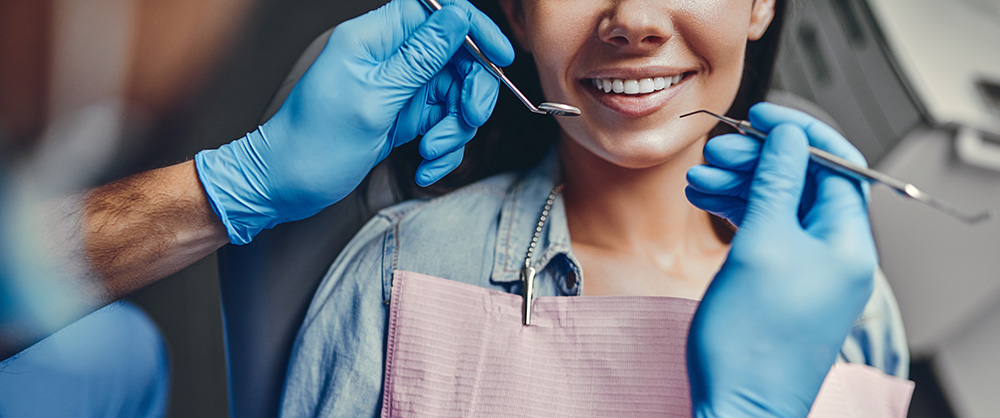General Dentistry

Keeping your oral health in top shape requires regular upkeep and ensuring you’re going for frequent check-ups. Dr Herman Jay is ready to assist you no matter your needs, whether it be a teeth cleaning, tooth restoration, extraction or in-depth diagnosis and treatment plan.
Dr Herman Jay offers several general dentistry services to help you maintain healthy teeth and gums and prevent severe conditions.
Routine Check-ups
Maintaining your oral health is about more than simply brushing and flossing every day, although those practices are crucial. You also need to make regular visits to your dentist for regular checks.
Dr Herman Jay is passionate about helping patients achieve their best smile and will provide a comprehensive examination of your teeth and gums to check for any issues that might have arisen since your last check-up. Should there be any concerns, Dr Herman will discuss them with you and provide the best course of action for treatment.
Teeth and gum cleanings are integral parts of your routine check-up as they ensure that all plaque and bacteria build-up is removed. Dr Herman Jay will perform the cleanings with the assistance of a dental hygienist and incorporate various tools to scrape and wash the surface of your teeth and gums. Dr Herman Jay will ensure your comfort throughout.
The final part of the cleaning includes a fluoride paste added to your teeth for about a minute to promote strength and support tooth enamel.
Ozone Dental Treatment
Many of us suffer from dental conditions such as tooth sensitivity, decay and infections. Ozone dental treatment is a natural treatment that uses ozonated water, or gas to treat the teeth.
The process is painless and non-invasive, making it a quick and efficient way to kill bacteria damaging the teeth. Dr Herman Jay will apply the water or gas to your teeth for a few minutes. Ozone treatment can also help to lessen sensitivity and pain.
Conditions ozone therapy treats
- Minor tooth decay
- Tooth sensitivity
- Tooth pain
- Periodontal diseases
Should you be experiencing any tooth sensitivity, pain or minor decay, contact Dr Herman Jay for a consultation. He may also suggest the ozone treatment during your routine check-up.
Gum Surgery
Gum surgery is used to treat gingivitis and periodontitis, two dental diseases that infect the gums. It is an invasive surgery that requires the numbing of the gums or going under local anaesthesia. However, the procedure is relatively quick and only requires a few hours.
What is gum disease?
Gingivitis is a mild form of gum disease characterised by redness, bleeding and swelling of the gums. In contrast, periodontitis is a more advanced stage of gingivitis that causes damage to the jaw bones and tissues. Apart from inflammation, you may also notice your teeth starting to separate from your gums, causing small spaces to form between the teeth.
Treatment for gum disease
Before treatment, Dr Herman Jay will do a thorough examination of your teeth and gums to assess the severity of the disease. He will then perform a deep clean on your gums using scaling and root planing methods to remove any bacteria or build-up.
Depending on the severity of your condition, Dr Herman Jay may make use of one or more of the following procedures:
- Bone grafting
- Tissue grafting
- Flap surgery
- Guided tissue regeneration
The surgery aims to restore the teeth and gums’ health and remove any dead or unhealthy tissue that may cause the disease to continue damaging your oral health.
Recovery from gum surgery
After the surgery, Dr Herman Jay will advise you on how to recover at home. You may experience some bleeding pain in the first few days of recovery, so Dr Herman Jay may prescribe some medication to assist with your healing.
Other practices you can follow include:
- Using an antiseptic mouthwash
- Eating soft foods
- Avoiding strenuous movement
- Avoiding alcohol and smoking
Tooth Extractions
Many teens and young adults have had extractions to remove their wisdom teeth, but tooth extractions are done for numerous reasons. It is one of the most common procedures required when a tooth cannot be saved.
Teeth may need to be removed due to:
- Tooth decay
- Overcrowding
- Wisdom teeth are lodged against the jaw
- Joint problems
- Shifting teeth
What to expect during tooth extractions
Removing teeth is typically a quick outpatient surgery that requires numbing or local anaesthesia. Dr Herman Jay will initially perform a complete examination of the impacted area and take an x-ray to plan the best extraction root. The procedure will be more complex if the tooth is broken under the gum.
It’s essential to inform Dr Herman Jay about any underlying diseases or conditions you have and the medication you are currently on before the surgery.
Tooth extraction recovery
After the surgery, Dr Herman Jay will give you gauze to stop the site from bleeding and allow it to form a clot. You will likely experience some minor bleeding in the days following your surgery, but it’s important not to disturb the extraction site. Dr Herman Jay will provide you with a comprehensive after-care guide but also ensure that you follow these instructions:
- Avoid harsh mouthwashes, and instead, use salt water to rinse your mouth
- Continue to clean your teeth as usual, but stay away from the extraction site
- Eat soft foods
- Use ice packs to reduce swelling
- Incorporate pain killers
Temporomandibular Joint (TMJ) Dysfunction

The temporomandibular joint (TMJ) is responsible for connecting the jaw and the skull in a sliding motion that allows us to open and close our mouths. TMJ disorders include conditions that cause pain and inflammation to the joint.
Conditions affecting the TMJ include:
- An improper bite
- Teeth grinding or clenching
- Arthritis
- Trauma
- Stress
- Breakdown of the joint
TMJ disorders are typically easy to treat, and surgery is only required as a last resort. In these cases, Dr Herman Jay will take an x-ray of the jaw to assess the damage to the joint. He will then provide you with a comprehensive overview of the surgical procedure.
Surgical treatment for TMJ dysfunction
Depending on your case, Dr Herman Jay may use one of several approaches to treat your TMJ dysfunction.
Arthrocentesis
This type of surgery is non-invasive and mainly used for locked jaws. Needles are inserted into the joint and release fluid to flush out debris and ease inflammation.
Arthroscopy
Arthroscopy uses an arthroscope to complete joint surgery and can even be as effective as open joint surgery. Surgery tools are inserted into the arthroscope to remove the inflamed tissue, leaving a minimal scar.
Open-joint surgery
Open-joint surgery serves as a last resort for treating TMD. It is an invasive procedure where the jaw joint is opened and repaired or replaced. Dr Herman Jay will thoroughly discuss your options for treatment, and if they involve open-joint surgery, he will ensure that you are aware of the entire procedure and the pros and cons.
Modified condylotomy
Modified condylotomy is another surgery for TMD, but instead of performing surgery on the jaw, it is performed on the mandible to relieve joint pain and inflammation.
Alternative treatments for TMJ dysfunction include:
- Fillers
- Physical therapy
- Mouthguards

